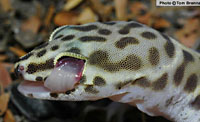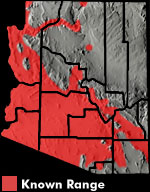Online Field Guide to The Reptiles and Amphibians of Arizona


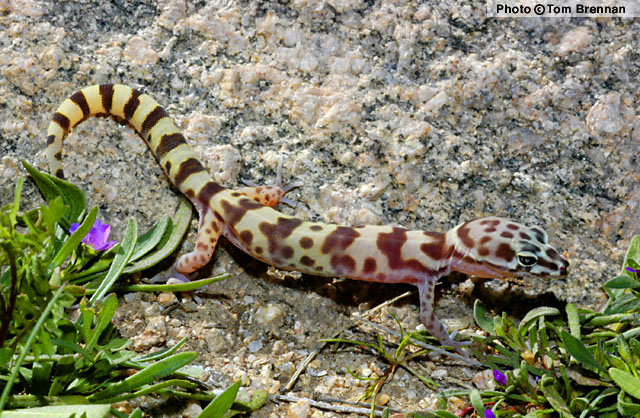
Yavapai County, AZ
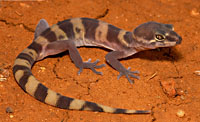 Cochise Co., AZ |
||
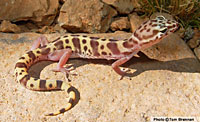 Pinal Co., AZ |
| WESTERN BANDED GECKO Coleonyx variegatus | |
|
DESCRIPTION: A small (up to 76 mm or 3″ from snout to vent) creamy yellow lizard with reddish brown crossbands, spots, and reticulations on the body and tail. The limbs and sides are tinted with with pink. The ventral surface is plain and pale. Juveniles usually have distinct dorsal bands that break up into spots and reticulations as the animal ages. Adults in the southeastern portion of our state tend to retain the juvenile banding. A creamy yellow line loops from the corner of the eye around the back of the head to the other eye like an eyeglass strap. Behind this loop is a broad, reddish brown collar. The scales are small and granular and the skin is soft and translucent. A faint, blue-green tint is visible through the skin above each eye. This gecko has slender toes, lacks toe pads, and lacks tubercles on the body distinguishing it from the similar looking Mediterranean House Gecko. The tail becomes plump when the animal is well fed. The pupils are vertically elliptical. Unlike many geckos this lizard has moveable eyelids. HABITAT: An inhabitant of our desertscrub communities. This deceptively delicate-looking lizard is capable of living in some of our states most harsh environments. It can be found in habitats ranging from extremely dry, wind blown sand dunes and creosotebush flats, through rugged rocky slopes and hillsides, to relatively barren high desert plateaus. BEHAVIOR: This lizard is a nocturnal ground-dweller. It is often seen prowling on the surface at night and is also easily found under surface cover such as boards and trash piles. It hibernates during the cold months of winter and late fall. When it senses danger it twists and undulates the tail in slow, sinuous, serpentine movements. The tail is easily cast off and regenerated. When captured it will often squeak. REPRODUCTION: This gecko lays up to 3 clutches of eggs per year. Eggs are laid in spring and summer and each clutch consists of 1 or 2 eggs. By Thomas C. Brennan Brennan, T. C., M. J. Feldner, H. F. Koenig. 2002. Coleonyx variegatus. Geographic Distribution. Herpetological Review. 33(4). p. 321. Brennan, T. C., & A. T. Holycross. 2006. A Field Guide to Amphibians and Reptiles in Arizona. Arizona Game and Fish Department. Phoenix, AZ Brennan, T. C., & A. T. Holycross. 2005. A Field Guide to Amphibians and Reptiles of Maricopa County. Arizona Game and Fish Department. Phoenix, AZ Persons, T. B., and E.M. Nowak. 2004. Coleonyx variegatus. Herpetological Review. 35 (1). Stebbins, R.C. 2003. A Field Guide to Western Reptiles and Amphibians, Third Edition. Houghton Mifflin Company, Boston, MA. |
|
Visit Partners in Amphibian and Reptile Conservation:


HOME
Copyright © 2023, Arizona Game and Fish Department. All rights reserved.
If you make use of the textual contents of this site in reports, publications, etc. please cite and credit the author(s) and photographer(s). All photos on this website are copyrighted. However, those found in the species account section may be used for any noncommercial scientific, educational, or conservation purposes provided that photographs are not altered and continue to bear the copyright symbol and name of the photographer. Please contact the photographer regarding commercial use of copyrighted photographs.











